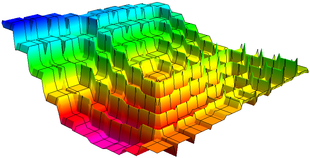10-327/Homework Assignment 6: Difference between revisions
No edit summary |
No edit summary |
||
| Line 2: | Line 2: | ||
{{In Preparation}} |
{{In Preparation}} |
||
===Reading=== |
===Reading=== |
||
'''Read''' sections |
'''Read''' sections 37-38 in Munkres' textbook (Topology, 2nd edition). Remember that reading math isn't like reading a novel! If you read a novel and miss a few details most likely you'll still understand the novel. But if you miss a few details in a math text, often you'll miss everything that follows. So reading math takes reading and rereading and rerereading and a lot of thought about what you've read. Also, '''preread''' sections 30-33, just to get a feel for the future. |
||
===Doing=== |
===Doing=== |
||
Solve and submit the following problems. |
|||
Solve the following problems from Munkres' book, though submit only the <u>underlined</u> ones: Problems ??? on pages ???. |
|||
'''Problem 1.''' Problem 1 on page 235 of Munkres' book. |
|||
'''Problem 2.''' Show that <math>\{0,1\}^{\mathbb N}</math> is homeomorphic to the cantor set <math>C</math>. |
|||
'''Problem 3.''' Show that any function <math>f\colon{\mathbb N}\to I^A</math> from the integers into a "cube" <math>I^A=[0,1]^A</math> has a unique continuous extension to <math>\beta{\mathbb N}</math>. |
|||
'''Problem 4.''' Use the fact that there is a countable dense subset within <math>I^I</math> to show that the cardinality of <math>\beta{\mathbb N}</math> is greater than or equal to the cardinality of <math>I^I</math>. |
|||
'''Problem 5.''' Show that the cardinality of <math>\beta{\mathbb N}</math> is also less than or equal to the cardinality of <math>I^I</math>, and therefore it is equal to the cardinality of <math>I^I</math>. |
|||
'''Problem 6.''' Show that if <math>\mu\in\beta{\mathbb N}\backslash{\mathbb N}</math> and if <math>\mbox{Lim}_\mu</math> is the corresponding generalized limit, and if <math>b</math> is a bounded sequence and <math>f\colon{\mathbb R}\to{\mathbb R}</math> is a continuous function, then <math>\mbox{Lim}_\mu f(b_k) = f(\mbox{Lim}_\mu b_k)</math>. |
|||
'''Problem 7.''' Show that there is no super-limit function <math>\mbox{SuperLim}</math> defined on bounded sequences of reals with values in the reals which has the following 3 properties: |
|||
# <math>\mbox{SuperLim}(a_k+b_k) = \mbox{SuperLim}(a_k) + \mbox{SuperLim}(b_k)</math>. |
|||
# <math>\mbox{SuperLim}(a_k\cdot b_k) = \mbox{SuperLim}(a_k) \cdot \mbox{SuperLim}(b_k)</math>. |
|||
# <math>\mbox{SuperLim}(a'_k) = \mbox{SuperLim}(a_k)</math>, where <math>a'</math> is <math>a</math> "shifted once": <math>a'_k=a_{k+1}</math>. |
|||
===Due date=== |
===Due date=== |
||
Revision as of 19:38, 11 November 2010
| ||||||||||||||||||||||||||||||||||||||||||||||||||||||||||||
The information below is preliminary and cannot be trusted! (v)
Reading
Read sections 37-38 in Munkres' textbook (Topology, 2nd edition). Remember that reading math isn't like reading a novel! If you read a novel and miss a few details most likely you'll still understand the novel. But if you miss a few details in a math text, often you'll miss everything that follows. So reading math takes reading and rereading and rerereading and a lot of thought about what you've read. Also, preread sections 30-33, just to get a feel for the future.
Doing
Solve and submit the following problems.
Problem 1. Problem 1 on page 235 of Munkres' book.
Problem 2. Show that is homeomorphic to the cantor set .
Problem 3. Show that any function from the integers into a "cube" has a unique continuous extension to .
Problem 4. Use the fact that there is a countable dense subset within to show that the cardinality of is greater than or equal to the cardinality of .
Problem 5. Show that the cardinality of is also less than or equal to the cardinality of , and therefore it is equal to the cardinality of .
Problem 6. Show that if and if is the corresponding generalized limit, and if is a bounded sequence and is a continuous function, then .
Problem 7. Show that there is no super-limit function defined on bounded sequences of reals with values in the reals which has the following 3 properties:
- .
- .
- , where is "shifted once": .
Due date
This assignment is due at the end of class on Thursday, November 18, 2010.
| Dror's notes above / Student's notes below |

![{\displaystyle [0,1]}](https://wikimedia.org/api/rest_v1/media/math/render/svg/738f7d23bb2d9642bab520020873cccbef49768d)







![{\displaystyle I^{A}=[0,1]^{A}}](https://wikimedia.org/api/rest_v1/media/math/render/svg/99f33088165d29d0d5a1afeb41724bf50de0f30e)













